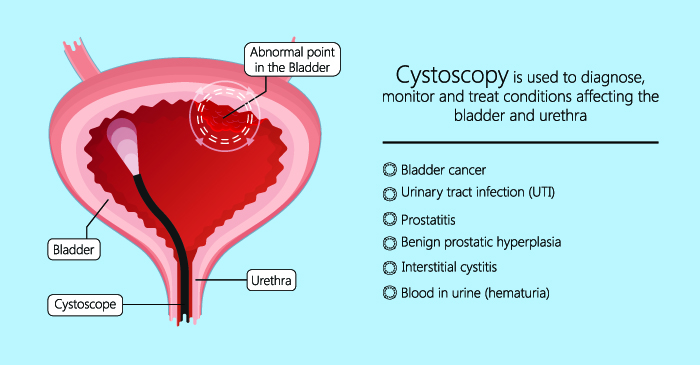Cystoscopy Surgery in Sadashiv Peth, Pune
Cystoscopy is a medical procedure through which the doctor examines the lining of the bladder and urethra (the tube carrying the urine out of your body). In the procedure, the doctor uses a holly tube called a cystoscope that is equipped with a lens. This cystoscope is inserted into the urethra and advanced slowly into the bladder. In simple terms, Cystoscopy is a procedure for checking the health of your bladder and urethra.

Types of Cystoscopy
Cystoscopy can be of two types - Flexible and Rigid. Both the procedure involving passing a cystoscope along the urethra and into the bladder, but in slightly different ways:
- Flexible cystoscopy - In this procedure, the doctor uses a thin and bendy cystoscope that is about the same width as a pencil. While the procedure is being performed, you will be awake.
- Rigid cystoscopy - In this procedure, the doctor uses a cystoscope that doesn’t bend. You will either be put to sleep for the procedure or your lower half of the body will be numbed.
Signs that you might need a cystoscopy
A cystoscopy is usually performed if you have been experiencing the following:
- Bladder control issues like urinary retention (not able to empty the bladder completely) or incontinence (not able to control the urine flow)
- Hematuria (bladder in urine)
- Bladder strokes
- Dysuria (painful urination)
- Frequent urinary tract infections (UTIs)
Why is Cystoscopy performed?
Cystoscopy is a procedure used for diagnosing, monitoring, and treating conditions that affect your bladder and urethra. Here are some main reasons why cystoscopy is performed:
- Find the cause of symptoms - Cystoscopy can help determine why you have been experiencing some symptoms like blood in the urine, overactive bladder, painful urination, incontinence, or frequent UTIs.
- Diagnose bladder conditions - This includes cystitis (bladder inflammation), bladder stones, and bladder cancer.
- Treat bladder conditions - Through the cystoscope, the doctor can pass other special tools for treating certain conditions.
- Diagnose enlarged prostate - The procedure can reveal narrowing of the urethra at the site where it passes through the prostate gland which indicates an enlarged prostate.
In some cases, the doctor performs a ureteroscopy with the cystoscopy to examine the ureters (tubes carrying urine from kidneys to the bladder)
When to see a doctor
If you experience any of the following after the cystoscopy procedure, you should immediately request an appointment at Apollo Spectra Hospitals:
- Not able to urinate
- Nausea and abdominal pain
- Heavy blood clots or bright red blood in the urine
- A fever with a temperature higher than 101.4 F (38.5 C)
- Chills
- Burning or pain while urination that lasts over two days
Request an appointment at Apollo Spectra Hospitals, Pune
Call 1860-500-2244 to book an appointment
Preparing for the cystoscopy
In order to prepare for cystoscopy, you will have to take antibiotics before and after the procedure, as prescribed by your doctor. This is very important, especially if you can’t fight off infections well. Also, before the procedure, you might have to take a urine test. Make sure that you don’t empty your bladder before coming for the cystoscopy as you might have to give a urine sample. If you will receive general anesthetic or intravenous (IV) sedation during your cystoscopy, you have to make plans for your recovery which includes having someone to drive you home.
Benefits of cystoscopy
Cystoscopy helps the doctors determine the cause of concerns like painful urination, blood in the urine, urinary retention, frequent urination, recurrent bladder infections, and pelvic pain.
Complications
Here are a few complications of the cystoscopy procedure:
- Infection
- Pain
- Bleeding
Treatment
Cystoscopy is a simple outpatient’s procedure that lasts for about 15 minutes. Here is how it is performed:
- Before the procedure, you will have to empty your bladder. Depending on your case, you might or might not need an anesthetic or a sedative.
- The doctor will apply a numbing jelly to the urethra. After a few minutes, they will push the cystoscope carefully into the urethra, with the smallest possible scope. If they have to pass surgical tools or take tissue samples, they might use larger scopes.
- Then, using the lens on the cystoscope that magnifies the inner surfaces of your bladder and urethra, the doctor will examine it. In some cases, the doctor places a video camera on the cystoscope to project the images onto a screen.
- Then, a sterile solution will be used to fill your bladder. It will inflate your bladder to provide a better look inside. During this time, the doctor might take tissue samples as well.
- Once this is done, they will take out the cystoscope and you will be encouraged to empty your bladder.
Conclusion
Immediately after the procedure, your doctor might discuss the results or they might wait for a follow-up appointment.
References:
https://my.clevelandclinic.org/health/diagnostics/16553-cystoscopy
https://www.healthline.com/health/cystoscopy
https://www.mayoclinic.org/tests-procedures/cystoscopy/about/pac-20393694
Cystoscopy is performed by a urologist.
A ureteroscope also has a rigid or flexible tube, an eyepiece, and a small lens with light. However, it is thinner and longer than a cystoscope so that it can see the detailed images of your ureters’ and kidneys’ lining.
Symptoms
Our Top Specialities
NOTICE BOARD
CONTACT US
CONTACT US
 Book Appointment
Book Appointment


.svg)
.svg)
.svg)
.svg)








